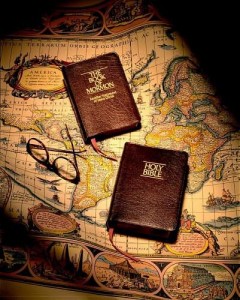The Doctrine and Covenants is the compilation of revelations received primarily by Joseph Smith Jr, but also by other early prophets of the Mormon Church, during the Church’s Restoration on the earth. The Doctrine and Covenants was originally known as the Book of Commandments. It contains divine instruction from the Lord on how to organize His Church once again on the earth. Mormons believe that, although most of the instructions and regulations are directed toward members of the Church, the warnings and messages are for the benefit of all mankind in the last days of the earth. Many of the revelations were published in Independence, Missouri, in 1833 under the title A Book of Commandments for the Government of the Church of Christ, and later an “enlarged compilation” of the record was published in Kirtland, Ohio, with the title Doctrine and Covenants of the Church of the Latter Day Saints. The first Twelve Apostles of the Church attached their testimony of the truthfulness of the book. (See the Doctrine and Covenants, “Explanatory Introduction.”)
 What does the Doctrine and Covenants reveal about the Lord’s organization for His Church? Priesthood is an important aspect of the restoration. In the beliefs of Mormonism, Joseph Smith received the priesthood, the divine authority to act in God’s name, from John the Baptist and Peter, James, and John. This priesthood had been lost from the earth with the death of the Apostles. The Doctrine and Covenants reveals two kinds of priesthood. The Aaronic Priesthood allows its holders to bless and pass the sacrament and to perform baptisms. The sacrament is holy bread and water representing the body and blood of Jesus Christ. Sacramental prayers are also given in the Doctrine and Covenants. The Melchizedek Priesthood allows its holders to serve as Mormon missionaries and give the gift of the Holy Ghost, among other responsibilities and ordinances, but the Melchizedek Priesthood is also the fullness of the priesthood. The prophets and apostles of the LDS Church need no higher priesthood than the Melchizedek – there is no higher priesthood.
What does the Doctrine and Covenants reveal about the Lord’s organization for His Church? Priesthood is an important aspect of the restoration. In the beliefs of Mormonism, Joseph Smith received the priesthood, the divine authority to act in God’s name, from John the Baptist and Peter, James, and John. This priesthood had been lost from the earth with the death of the Apostles. The Doctrine and Covenants reveals two kinds of priesthood. The Aaronic Priesthood allows its holders to bless and pass the sacrament and to perform baptisms. The sacrament is holy bread and water representing the body and blood of Jesus Christ. Sacramental prayers are also given in the Doctrine and Covenants. The Melchizedek Priesthood allows its holders to serve as Mormon missionaries and give the gift of the Holy Ghost, among other responsibilities and ordinances, but the Melchizedek Priesthood is also the fullness of the priesthood. The prophets and apostles of the LDS Church need no higher priesthood than the Melchizedek – there is no higher priesthood.
The Doctrine and Covenants also reveals the need for and purpose of Mormon temples. The first revelations about modern temples are recorded in the Doctrine and Covenants. Under the Lord’s direction, the Mormons would build first a temple in Kirtland and, then, a temple in Nauvoo, Illinois. These temples were houses built unto the Lord, and revelations afterward were often received in them. Key ordinances in the Mormon faith were also revealed, such as endowments and baptism for the dead.
Joseph Smith and Prophet Joseph F. Smith also received knowledge of the state of spirits after death. Mormons believe in kingdoms of heaven – the celestial kingdom being the highest, but even the lowest, the telestial, being a glorious place. They also believe that those who died without a knowledge of the gospel can be saved in the celestial kingdom if Mormons perform such ordinances as baptisms for them by proxy. Then, those spirits will have the opportunity to accept, or reject, the gospel after life on earth. Joseph F. Smith saw a vision of the spirits of the dead, and that they have volition and the ability to learn. He saw the gospel of Christ being taught to them, in preparation for resurrection and judgment.
Among these and many other revelations of doctrine, ordinances, and organization, the Doctrine and Covenants also reveals some aspects of Mormon history. Some of Joseph Smith’s prayers, both dedicatory and formal and those given in jail or in times of anguish, are recorded here. Callings for individual members and Churchwide decisions, such as moving to another state as a body, or building a temple, are also recorded. So is there an account of Joseph Smith’s assassination and martyrdom. The Doctrine and Covenants is one of the core Mormon books of scripture and an extensive record of the early Church – its revelations, its struggles, and its movements.
Additional Resources:
